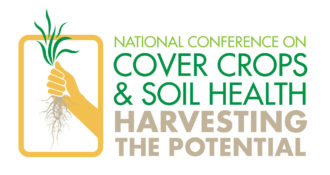Session recordings on this page include:
- Cover Crops and Nutrient Management
- Cover Crop Impacts on Diseases and Insects
- Cover Crops, Herbicides and Dealing with Herbicide-Resistant Weeds
Cover Crops and Nutrient Management
The use of cover crops can have a significant impact in reducing nutrient losses in fields and affecting overall nutrient availability in soils. Speakers in this session will share some of the latest research on the impacts of cover crops on soil health including:
- How to fully utilize cover crops for the benefits of cash crop production, nutrient management, and soil health
- How different cover crop species impact soil nutrients under various soil types and management systems
- The impact of cover crops on water quality improvement
Matt Ruark, University of Wisconsin (PDF) (PDF)
Shalamar Armstrong, Purdue University (PDF)
Steven Mirsky, USDA-ARS (PDF)
Cover Crop Impacts on Diseases and Insects
Cover cropping represents a simple and powerful tool for sustaining pollinator and beneficial insect populations in agroecosystems. Mass pollen and nectar resources from flowering cover crops can fill a critical role in crop systems that may normally be devoid of food for beneficial insects (such as cereal grains). Use of cover crops to support beneficial insects is aligned with the traditional soil health goals of cover cropping. Highlights of this session include:
- Introduction and overview of the latest science and practice of pollinator and beneficial insect conservation using cover crop practices
- Conservation threats to pollinators and real world case studies of natural pest suppression by beneficial insects through the use of cover crops
- Experimental new cover crop species
- Management of cover crops to mitigate beneficial insect harm (such as pesticide risk reduction, termination practices)
- Results from a three-year study in western and east-central Illinois that evaluated the effects of several fall planted cover crops on disease development in following soybean crops
Darin Eastburn, University of Illinois, retired (PDF)
Eric Lee-Mader, Xerces Society (PDF)
Cover Crops, Herbicides and Dealing with Herbicide-Resistant Weeds
Though delaying cover crop termination shows potential for improving weed management, there are several factors (e.g., equipment limitations, growing season windows, and pest management) that may prevent adoption of this practice. What is the most important limiting factor? You will leave this presentation with a better understanding of how herbicide selection can influence cover crop success. Highlights include:
- How environmental conditions and soil type influence herbicide dissipation
- How integrating cover crops into annual grain rotations can help diversify weed management and preserve the use of effective herbicides in conservation tillage systems
- How new cover cropping strategies that allow for delayed cover crop termination and greater cover crop biomass accumulation can improve weed suppression and herbicide management in annual grain systems
- Outline of potential agronomic tradeoffs that might limit the adoption of these new strategies
Bill Curran, Penn State University (PDF)
John Wallace, Cornell University (PDF)
The following session recordings are available:
